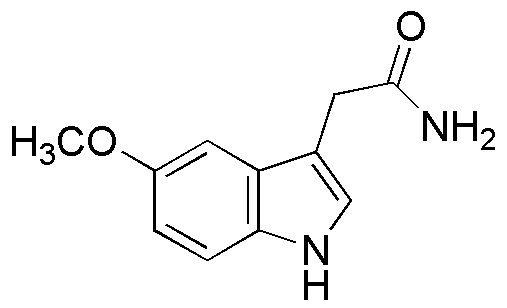5-Methoxyindole-3-acetamide is widely utilized in research focused on:
- Pharmaceutical Development: This compound is explored for its potential therapeutic effects, particularly in the treatment of neurological disorders, due to its ability to interact with serotonin receptors.
- Biochemical Research: It serves as a valuable tool in studying indole derivatives, aiding researchers in understanding their biological activities and mechanisms.
- Natural Product Synthesis: The compound is used in the synthesis of various natural products, providing a pathway for the development of new drugs and bioactive compounds.
- Cosmetic Formulations: Its antioxidant properties make it a candidate for inclusion in skincare products, helping to protect skin from oxidative stress.
- Plant Growth Regulation: Research indicates its potential role in influencing plant growth, making it relevant for agricultural applications in enhancing crop yield.
General Information
Properties
Safety and Regulations
Applications
5-Methoxyindole-3-acetamide is widely utilized in research focused on:
- Pharmaceutical Development: This compound is explored for its potential therapeutic effects, particularly in the treatment of neurological disorders, due to its ability to interact with serotonin receptors.
- Biochemical Research: It serves as a valuable tool in studying indole derivatives, aiding researchers in understanding their biological activities and mechanisms.
- Natural Product Synthesis: The compound is used in the synthesis of various natural products, providing a pathway for the development of new drugs and bioactive compounds.
- Cosmetic Formulations: Its antioxidant properties make it a candidate for inclusion in skincare products, helping to protect skin from oxidative stress.
- Plant Growth Regulation: Research indicates its potential role in influencing plant growth, making it relevant for agricultural applications in enhancing crop yield.
Documents
Safety Data Sheets (SDS)
The SDS provides comprehensive safety information on handling, storage, and disposal of the product.
Product Specification (PS)
The PS provides a comprehensive breakdown of the product’s properties, including chemical composition, physical state, purity, and storage requirements. It also details acceptable quality ranges and the product's intended applications.
Certificates of Analysis (COA)
Search for Certificates of Analysis (COA) by entering the products Lot Number. Lot and Batch Numbers can be found on a product’s label following the words ‘Lot’ or ‘Batch’.
*Catalog Number
*Lot Number
Certificates Of Origin (COO)
This COO confirms the country where the product was manufactured, and also details the materials and components used in it and whether it is derived from natural, synthetic, or other specific sources. This certificate may be required for customs, trade, and regulatory compliance.
*Catalog Number
*Lot Number
Safety Data Sheets (SDS)
The SDS provides comprehensive safety information on handling, storage, and disposal of the product.
DownloadProduct Specification (PS)
The PS provides a comprehensive breakdown of the product’s properties, including chemical composition, physical state, purity, and storage requirements. It also details acceptable quality ranges and the product's intended applications.
DownloadCertificates of Analysis (COA)
Search for Certificates of Analysis (COA) by entering the products Lot Number. Lot and Batch Numbers can be found on a product’s label following the words ‘Lot’ or ‘Batch’.
*Catalog Number
*Lot Number
Certificates Of Origin (COO)
This COO confirms the country where the product was manufactured, and also details the materials and components used in it and whether it is derived from natural, synthetic, or other specific sources. This certificate may be required for customs, trade, and regulatory compliance.


